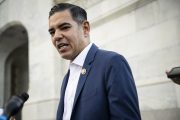
Most of the nation’s sheriffs, who operate about 85 percent of U.S. jails, are supportive of President Trump’s efforts to deport the many illegal aliens within our borders. However, some of them are uncertain about their legal right to hold prisoners for possible deportation, even at the request of federal authorities. Much of this uncertainty stems from a 2014 ruling by a U.S. District Court of the Northern District of Illinois that invalidated the federal government’s practice of issuing detainers against people in law-enforcement custody. In the case of Jimenez Moreno et al v. Napolitano, the court ruled that the practice of issuing detainers exceeds the government’s limited warrantless arrest authority under federal immigration laws.
Immigration detainers are written requests sent by ICE that ask local police to detain individuals beyond the time when they otherwise should be released, ostensibly so the immigration agency may take the individuals into custody.
While the ruling in the class-action lawsuit Jimenez Moreno et al v. Napolitano only invalidates detainers issued out ICE’s Chicago Field Office, it set a legal precedent that casts doubt on the millions of detainers issued by ICE over the past decade — doubt that concerns many people in law enforcement responsible for honoring them.
That uncertainty aside, Trump’s January 25 executive order (“Enhancing Public Safety in the Interior of the United States”) proclaiming that “sanctuary jurisdictions across the United States willfully violate Federal law in an attempt to shield aliens from removal from the United States” has emboldened officials in many jurisdictions. In an article posted today by The New American, journalist Bob Adelmann observed that in response to Trump’s executive order a number of cities that formerly considered themselves as “sanctuary cities” for illegal immigrants are reversing their policies. Among the jurisdictions doing so are Miami-Dade, Florida; Dayton, Ohio; Saratoga, New York; Finney County, Kansas; and Bedford, Pennsylvania.
The article cited Marguerite Telford, director of communications for the Center for Immigration Studies (CIS), who said that her group is “being inundated” with calls from officials of other cities asking that CIS remove their names from the group’s listing of sanctuary cities.
The report also listed a number of states with Republican majorities in their legislatures that are also ending sanctuary status, including Idaho, Texas, Iowa, Michigan, Ohio, Tennessee, Florida, North Carolina, and Pennsylvania.
Though the Trump administration has gotten off to a fast start in reversing the lax immigration enforcement polices that existed under President Obama, it is still too soon for these policies to have produced any measurable effects. A February 13 Fox News report, for example, noted that Mexico’s Foreign Minister Luis Videgaray stated that day that there has not been a rise yet in the number of deportations of Mexicans from the United States under Trump. However, he did say that Mexican consulates in the United States have received at least three times as many daily phone calls from worried Mexican citizens, compared to before Trump took office. He attributed the increase to news of possible increased deportations under Trump.
“It’s grown exponentially,” said Videgaray, who added that Mexicans living in the United States were calling with questions, complaints, and worries about the immigration enforcement process, rather than because of any increase in the number of raids on illegal aliens.
A report in The Hill on February 11 noted that the recent highly publicized deportation of Arizona resident Guadalupe Garcia de Rayos has put communities with large numbers of illegal aliens or “mixed status” households (with both legal and illegal residents) on edge. “It’s fair to say we’re all extremely troubled by the deportation action we saw take place yesterday in Arizona,” the report quoted Janet Murguia, president of the National Council of La Raza. “The first deportation [after Trump’s] executive order is of a working mom with two U.S. kids,” Murguia added.
A report in the Washington Post on February 11 observed that federal officials maintain they have not made notable changes in enforcement actions, and also deny they are stopping people randomly at checkpoints or conducting “sweeps” of locations where illegal aliens are commonly found.
However, noted the report:
Anxiety among immigrants spiked last week after the Immigration and Customs Enforcement agency conducted a series of enforcement actions in large metropolitan areas, detaining hundreds of people in Chicago, Los Angeles, New York, Atlanta, and other cities.
The Post noted that members of the Congressional Hispanic Caucus have demanded an immediate meeting with Thomas D. Homan, the acting head of ICE. “These raids have struck fear in the hearts of the immigrant community as many fear that President Trump’s promised ‘deportation force’ is now in full-swing,” the lawmakers wrote in a letter to Homan.
An article posted by New York magazine on January 26 suggested that the Trump administration’s stepped-up immigration enforcement initiatives are part of a strategy to encourage self-deportation. Whether or not this is true is difficult to verify at such an early stage. If it is, however, it might not be such a bad strategy, since every illegal alien who self-deports frees up resources that our immigration authorities might dedicate toward deporting those who are intent on remaining, despite their illegal status.
The problem with New York’s report, however, is that it impugns the motives of the new administration’s efforts to enforce the law by playing the race card. (As one example of this unabashed attempted to equate immigration enforcement with racism, the writer states: “Combined with Trump’s regular statements of support for racial profiling as a law-enforcement tool, a self-deportation strategy could make the United States a very uncomfortable place for nonwhite people, just as it has been so often in the past (you know, those years of greatness Trump’s core supporters want to bring back).”
The writer’s assertion ignores the fact that the vast majority of “non-white” people in the United States are native-born U.S. citizens of African ancestry whose livelihood the Trump administration intends to protect by not allowing legions of illegal aliens into the country to take their jobs.
But perhaps the soundest strategy for encouraging self-deportation was proposed sometime back by former Representative Ron Paul (R-Texas) who suggested that if we just eliminated the many benefits that attract illegal aliens to our country, they would not come here — or would leave. In one public forum, Paul said: “We’re in worse shape now because we subsidize immigration. We give food stamps, Social Security, free medical care, free education and amnesty. So you subsidize it, and you have a mess.”
Cutting out the incentives that entice foreign nationals to enter our country illegally would eliminate the need for deportation of any type, whether enforced by the government or engaged in by the illegal aliens themselves.
Related articles:
Number of Former Sanctuary Cities Reversing Policy
Trump Signs Executive Orders to Build Border Wall and Strengthen Immigration Enforcement
California Advances Bills to Become Sanctuary State
San Francisco Sues Trump to Stop Executive Order About Sanctuary Cities
Illegal Alien Sues San Francisco for Violating Sanctuary City Law




